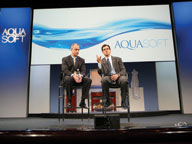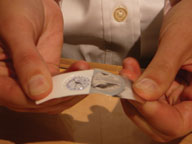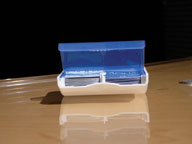As high profile launches go, Clearlab’s announcement of its flatpack AquaSoft Singles contact lens was up there with the best of them. The main difference with this announcement was that it was introducing a ‘concept’ rather than a live product.  That aside, the audience packed into New York’s Equitable Auditorium appeared genuinely impressed by the technology introduced as AquaSoft Singles. This is a contact lens package which flattens the contact lens within the packing to create a carrier just 1mm thick.
That aside, the audience packed into New York’s Equitable Auditorium appeared genuinely impressed by the technology introduced as AquaSoft Singles. This is a contact lens package which flattens the contact lens within the packing to create a carrier just 1mm thick.
The unique selling points of AquaSoft Singles don’t end there. The design of the carrier is such that when the foil is separated from the prolypropolyne base the lens is lifted up on a former which presents the lens outside first to the wearer. The lens is then simply  pinched off and inserted, leaving the front surface untouched. Adding to the list of patented features of the Singles blister system is bold left and right lettering on the package and the ability to deliver pairs of lenses as lefts and rights to the wearer in the secondary lens packaging. This enables a month’s supply of Singles to be delivered in a plastic matchbox-sized dispenser which releases the lenses one-by-one. Another credit card-style carrier allows two pairs of lenses to be kept in a wallet.
pinched off and inserted, leaving the front surface untouched. Adding to the list of patented features of the Singles blister system is bold left and right lettering on the package and the ability to deliver pairs of lenses as lefts and rights to the wearer in the secondary lens packaging. This enables a month’s supply of Singles to be delivered in a plastic matchbox-sized dispenser which releases the lenses one-by-one. Another credit card-style carrier allows two pairs of lenses to be kept in a wallet.
All of these, many patented, features were developed as a result of research into users’ habits, said Clearlab. On hand to provide some detail was Professor Nathan Efron, flown in from Brisbane for the event. In a slick double-act with US anchorman Forrest Sawyer, Efron explained that the success of all contact lens systems was dependent upon the lens, the solutions and the packaging.
On hand to provide some detail was Professor Nathan Efron, flown in from Brisbane for the event. In a slick double-act with US anchorman Forrest Sawyer, Efron explained that the success of all contact lens systems was dependent upon the lens, the solutions and the packaging.
The first part of the presentation extolled the virtues of the daily disposable modality. This may be an argument largely won in Europe but penetration of dailies in the US is still low.
Efron said research showed that 40 per cent of wearers allowed tap water to come into contact with their case, that cases weren’t replaced often enough and that, taking all elements into consideration, cleaning compliance failure rates were as high as 97.5 per cent.
Solutions posed further issues while packaging created a number of problems. Patients have to read very small print to identify left and right. A tough task without their lenses in. Often patients sacrifice visual acuity for simplicity and request lenses of the same power to make life simple.
Register now to continue reading
Thank you for visiting Optician Online. Register now to access up to 10 news and opinion articles a month.
Register
Already have an account? Sign in here
